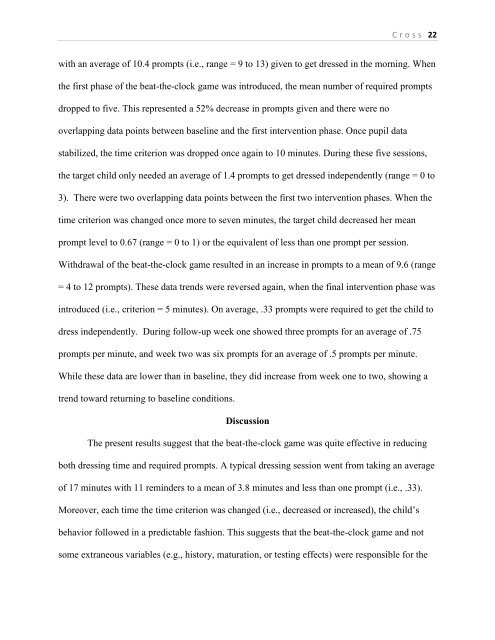THE EFFECTS OF A TIMER AND MYSTERY MOTIVATORS ON THE ...
THE EFFECTS OF A TIMER AND MYSTERY MOTIVATORS ON THE ...
THE EFFECTS OF A TIMER AND MYSTERY MOTIVATORS ON THE ...
Create successful ePaper yourself
Turn your PDF publications into a flip-book with our unique Google optimized e-Paper software.
C r o s s 22<br />
with an average of 10.4 prompts (i.e., range = 9 to 13) given to get dressed in the morning. When<br />
the first phase of the beat-the-clock game was introduced, the mean number of required prompts<br />
dropped to five. This represented a 52% decrease in prompts given and there were no<br />
overlapping data points between baseline and the first intervention phase. Once pupil data<br />
stabilized, the time criterion was dropped once again to 10 minutes. During these five sessions,<br />
the target child only needed an average of 1.4 prompts to get dressed independently (range = 0 to<br />
3). There were two overlapping data points between the first two intervention phases. When the<br />
time criterion was changed once more to seven minutes, the target child decreased her mean<br />
prompt level to 0.67 (range = 0 to 1) or the equivalent of less than one prompt per session.<br />
Withdrawal of the beat-the-clock game resulted in an increase in prompts to a mean of 9.6 (range<br />
= 4 to 12 prompts). These data trends were reversed again, when the final intervention phase was<br />
introduced (i.e., criterion = 5 minutes). On average, .33 prompts were required to get the child to<br />
dress independently. During follow-up week one showed three prompts for an average of .75<br />
prompts per minute, and week two was six prompts for an average of .5 prompts per minute.<br />
While these data are lower than in baseline, they did increase from week one to two, showing a<br />
trend toward returning to baseline conditions.<br />
Discussion<br />
The present results suggest that the beat-the-clock game was quite effective in reducing<br />
both dressing time and required prompts. A typical dressing session went from taking an average<br />
of 17 minutes with 11 reminders to a mean of 3.8 minutes and less than one prompt (i.e., .33).<br />
Moreover, each time the time criterion was changed (i.e., decreased or increased), the child’s<br />
behavior followed in a predictable fashion. This suggests that the beat-the-clock game and not<br />
some extraneous variables (e.g., history, maturation, or testing effects) were responsible for the
















